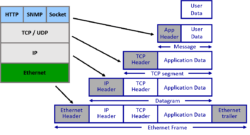PROFINET is an open Industrial Ethernet standard. It is a communication protocol that exchanges data between automation controllers and devices. With over 25 million installed nodes (as of 2018), PROFINET is one of the most widely used Industrial Ethernet standards worldwide. But even though millions of users are familiar with PROFINET, not all users understand how it works. PROFINET has 3 communication channels: TCP/IP and UDP/IP, Real-Time (RT), and Isochronous Real-Time (IRT).
The 3 Communication Channels
PROFINET can use TCP/IP (or UDP/IP) communications for certain non-time critical tasks, such as configuration, parameterization, and diagnostics. When sending data via TCP/IP, additional information is added to the data packet as it ‘moves’ through the layers of the ISO-OSI model. As shown in the diagram, the additional information makes Ethernet frames relatively large. When sending such Ethernet frames, the sender ‘packs’ the data and the receiver ‘unpacks’ it. Generally, this process is called encapsulation. Encapsulation can add significant jitter and latency. Therefore, the TCP/IP communication channel is unsuitable for time-critical tasks.
PROFINET RT handles time-critical data exchange. An arriving PROFINET RT Ethernet frame has the PROFINET EtherType: 0×8892. Upon arrival, the frame is directed to the PROFINET application directly from Layer 2 to Layer 7. The frame skips the TCP/IP layers and avoids the variable time it takes to be processed. Thus, communication speed and determinism improve significantly. PROFINET RT meets more than 90% of industrial automation timing requirements, and almost all PROFINET frames are sent via this method.
Finally, for the most demanding applications, PROFINET can use additional techniques for even faster performance with the PROFINET IRT channel. PROFINET IRT is a step beyond PROFINET RT. Unavoidably, under high network traffic, some time-critical messages can gain jitter. IRT eliminates those delays by enhancing the rules employed to switch Ethernet traffic, and by creating special rules for this PROFINET traffic.
If you would like to learn more about PROFINET’s 3 communication channels and how they fit in the ISO OSI model read the “PROFINET for Network Geeks(and those who want to be)” white paper. This resource is available for download HERE
-Nelly Ayllon

